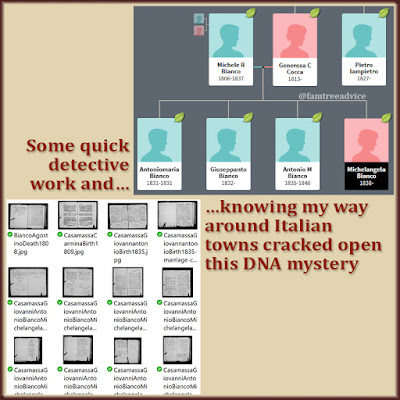There was a time when arranged marriages were expected and accepted.
It makes me chuckle when I see matching spouse names on 1800s vital records. "This baby is born to Tommaso and Tommasina." "He was the son of the late Giovanni and Giovanna." What a cute coincidence.
But, was it a coincidence? Or did two families who were planning to join their families decide to pair up the kids with similar names?
Why am I thinking about arranged marriages, you ask? I have an awesome book that documents my ancestral hometown in 1742. Like a modern-day census, it lists the names and ages of everyone in each household. It also lists the head of household's:
- land, and its use
- animals
- tax rate, and
- how many virgins he has
Yup. It lists the family's names as:
- husband
- wife
- sons in descending age order
- virgin daughters in descending age order
This made it clear to me that having a marriageable daughter was an asset. He may even have been taxed on his daughters.
 |
| A proper match was often the decision of the father of the bride. |
I've always known that my maternal grandparents had an arranged marriage in New York City in 1922. Grandma Mary liked a young man with red hair, but my great grandfather made the choice for her. He chose my grandfather Adamo for his eldest daughter.
After researching my great grandparents, it's clear they had an arranged marriage, too. Great grandpa Pasquale Iamarino came to America in 1902. By 1905 he was in upstate New York working for the Erie Railroad. There he met the Caruso brothers. They came to America from a town very close to Pasquale's hometown in Italy.
When the only girl in the Caruso family came to America in 1906, she married Pasquale 4 months later. Her brothers surely made the match.
 |
| It's clear the Caruso brothers chose Pasquale for their only sister. |
Then there's Pasquale's daughter Lucy—my paternal grandmother. As a kid, I thought it was a coincidence that my grandparents, Lucy and Pietro, had the same last name of Iamarino. But no. Our last name is rare, and my grandparents were 3rd cousins.
When my grandfather, Pietro Iamarino, came to America, he bounced around a bit. He went up to Boston where his mother's brother lived. Then he went to western Pennsylvania, where many of his townsmen worked. His next stop was Ohio, where he lived in the house of his father's 2nd cousin…Pasquale Iamarino. Within months, he married his 3rd cousin and housemate, Lucy.
For most of us, the idea of marrying a person your family chooses for you is hard to imagine. It's something we know from movies and from other cultures. But it has nothing to do with us.
Yet, I have to go back only to my grandparents to find arranged marriages in my family.
In my rural Italian hometowns, I often see marriages between neighboring families. A family with one tract of land might marry their daughter to the son of a family with the neighboring tract of land. In this way, the 2 families increase their relative wealth and prosperity.
I've heard my grandmother's youngest sister Aida adored her husband Arturo. Did my great grandfather give in to true love between Grandma's 1922 marriage and Aunt Aida's 1936 marriage? In 1928, the middle sister, Stella Sarracino, married Attilio Sarracino. Same last name, with roots in the same tiny Italian town. Maybe it was pure luck that Aida was head-over-heels in love with her husband Arturo.
By the time my parents were growing up, arranged marriages were no longer common. Did my grandmothers long to see their children marry for love? On her deathbed, Grandma Lucy urged my father to marry his childhood sweetheart back home. And so he did.
Throughout history, families made arranged marriages to:
- Keep bloodlines pure
- Join assets, wealth, and power
- Forge strategic alliances
My godmother/cousin once told me that our family "married within their tribe." That's part of the reason why all my roots lie in a very condensed area of Southern Italy. Even in America, they were more likely to marry someone who spoke the same dialect of Italian. That made a good match.
Take another look at your married ancestors. Can you find any likely arranged couples?













